|
Örjan Martinsson
| |
|

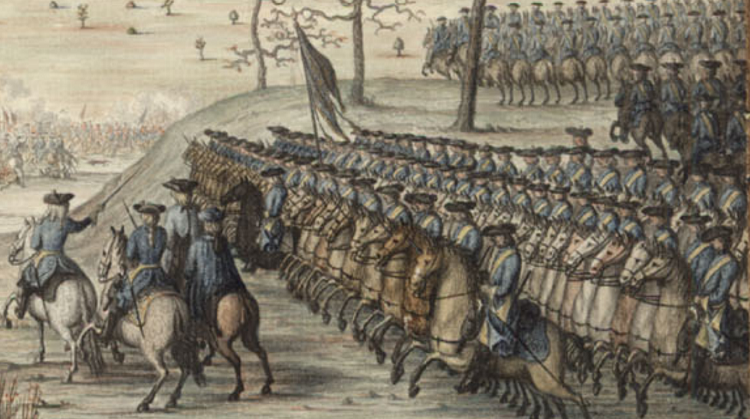
A detail from an illustration of the battle of Gadebusch 1712 which was
made by Magnus Rommel who participated in the battle as Swedish
quartermaster general.
In the beginning of the Great Northern War the Swedish
Carolean soldiers did not look quite like they are commonly depicted in
modern illustrations. The hats had not yet developed into tricornes even if
they were not far removed from them. They usually had two sides folded up in
various combinations, including some that looked like tricornes from the
front but like floppy hats from behind. The first unambiguous evidence of
tricornes among Swedish soldiers are from 1704 and 1705, and they probably
spread quite rapidly at that time.
Not even the for Caroleon soldiers so characteristic
turnbacks were in general use in the beginning of the war. In the infantry
they appear to have been non-existent, but a few examples of cavalrymen
wearing turnbacks can be found even before the war began. Since Charles XII
himself preferred to be depicted with cavalry boots and turnbacks, it is
likely that they soon became standard in at least the cavalry. When they
were introduced in the infantry is more uncertain and the first evidence of
the infantry having turnbacks is not earlier than from an illustration of
the battle of Gadebusch 1712. The artillery did not introduce turnbacks
until the 1720s. But if it was Charles XII who was responsible for the
introduction of turnbacks then it is likely that the infantry had turnbacks
already before the Russian campaign 1707–1709. Because Charles XII would
have had very limited opportunities to influence the appearance of the
uniforms during his exile in the Ottoman Empire 1709–1714.
At the bottom of the page
there is a presentation of how the uniforms are depicted in contemporary
paintings of the battle of Narva and Düna. A more detailed article about
the evolution of the Swedish Carolean uniform is
also available.
Information about the colour of the neck cloths is scarce and in uncertain cases
I have depicted them as white without explanation (this despite the fact that the most common
colour was black). However, an overview of what is known about the neckcloth colours can be found on
this page.
Note that the Finnish cavalry regiments are described on a
separate page together with the
Finnish infantry regiments.
|
|
Livregementet till häst
(Life Regiment on Horse)
The colour of the shabraques
(which had three crowns in yellow in the outer corners) is only mentioned
for the year 1700 and described as just "blue" while the coat and its lining
is described as light blue. For the years 1703/06 Höglund writes that the
coat was light blue with blue lining. |
|
Östgöta Cavalry Regiment
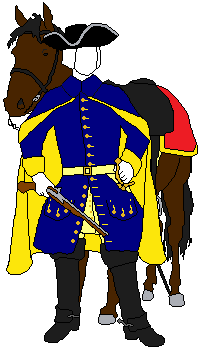
1700-? |
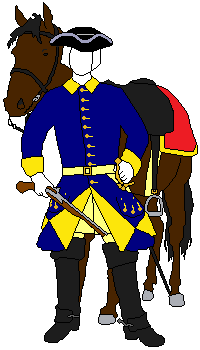
?-1709 |
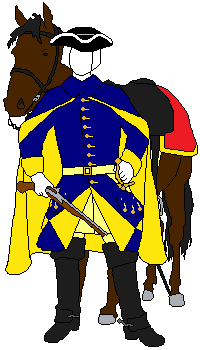
1710-1718 |
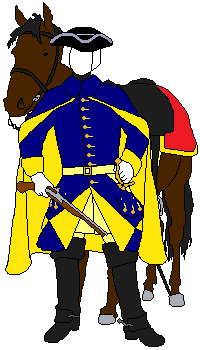
1719- |
The cloaks on all pictures follow the description of those that were
ordered in 1717 (blue cloak with blue collar and yellow lining). For the
year 1700 it is only mentioned as “blue" and for 1710 Höglund writes
that the whole uniform, with the exception of white hat lace, identical
with the one from 1700.
The appearance of the shabraques is only
described for the year 1700 and in the order from 1717 (which was not
delivered in time for the Norwegian campaign in 1718). They are
identical with the only difference that the latter mention that a
griffon in yellow wool decorates the outer corners. |
|
Småland Cavalry Regiment
|
|
Södra Skånska Cavalry
Regiment
(South Scanian)
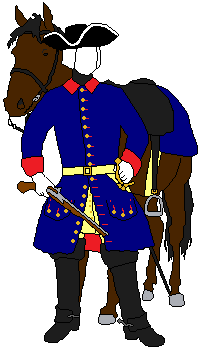
-1700 |
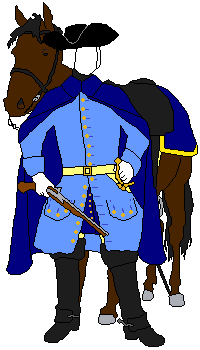
1701-1703 |
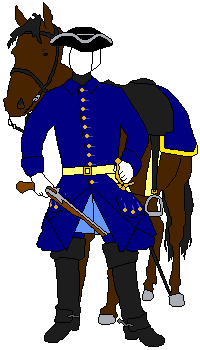
1703-? |
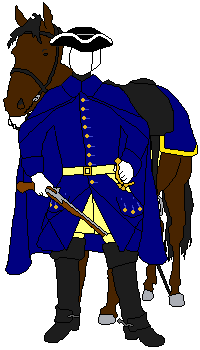
1711- |
|
Ten-year-old uniform which was donated to Skånska
3-männings Regiment after the outbreak of the war. Colour of hat lace,
buttons and shabraque unknown. |
Old light blue coats were used to manufacture vests but
recruits had leather vests and leather breeches in 1704. Button and shabraque colour
unknown. Hats with silver lace 1704. New uniform issued 1706/07 but not
described in the sources. |
Colour on hat lace, buttons lining and cuffs not
mentioned. Only 223 cavalrymen had approved equipment at the general
muster in 1711. |
|
|
Norra Skånska Cavalry
Regiment
(North Scanian)
|
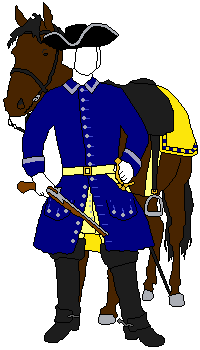
1702-? |
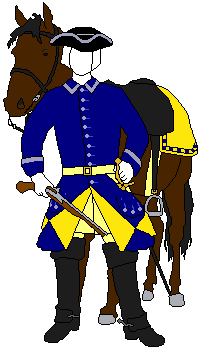
?-1709 |
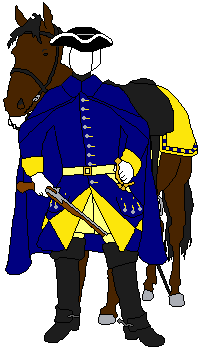
1710- |
|
The shabraques were decorated with the royal cypher and
crown. Uniform issued before 1702 is unknown. |
No uniform information between 1702 and 1710. |
Button colour as well as the cloak’s lining and collar
not mentioned. |
|
|
Riksänkedrottningens livregemente till häst
(Queen Dowager's Life Regiment on Horse)
|
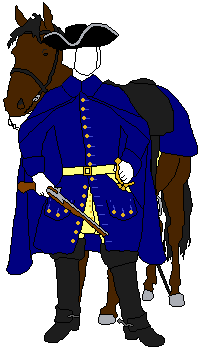
1702-1708 |
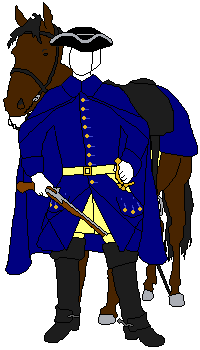
1708-1713 |
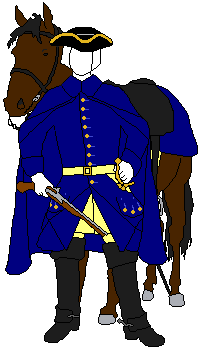
1714-1720 |
|
Uniform before 1702 is unknown, but old hats with narrow
gold lace from 1701 were recycled in 1715. |
When the regimen received new uniforms in 1708, the
colour on cloaks and coats did not match the prescribed cloth samples.
Colour of the shabraques not mentioned |
Button colour unknown. |
|
|
Bohuslän Dragoon Squadron
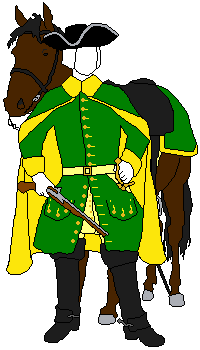
1702 |
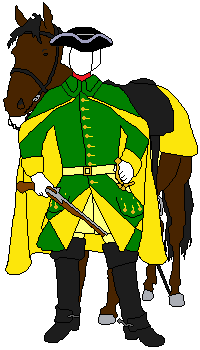
1712 |
|
|
Västgöta Cavalry Regiment
|
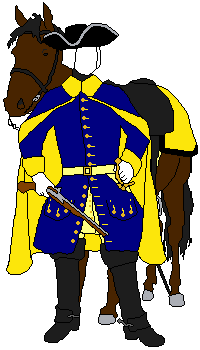
1700-? |
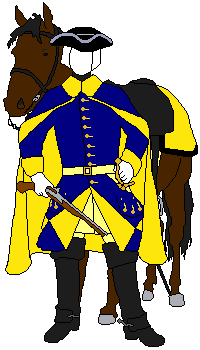
?-1713 |
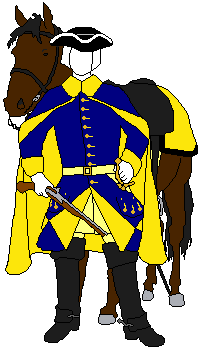
1714-
Button colour and shabraques not mentioned. |
|
|
Jämtland Cavalry Company
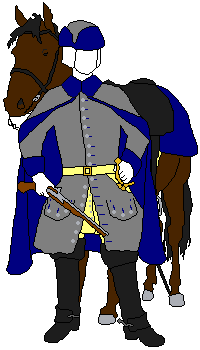
1695-? |
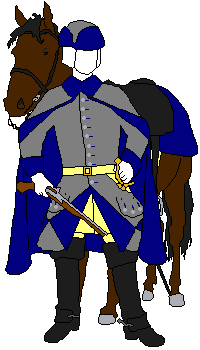
?-1722
The company is reported in 1717 to have had 125 hats as
well as blue cloaks together with grey karpuses and old grey cloaks. |
|
|
Swedish Adelsfana
|
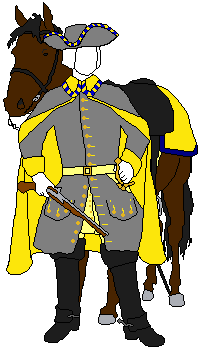
1689-1704 |
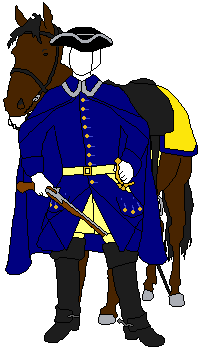
1704-1709 |
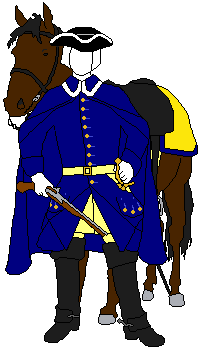
1710-? |
|
The shabraques had a blue royal crown in the outer corners. |
Recruits received in 1705 hats with white lace instead of
silver lace as well as grey piecoats instead of cloaks.
The appearance of the shabraques are only described for the period of 1689-1704. |
According to Anders Larsson, lace on both the hat and the
cloak’s collar were white (Höglund have silver hat lace). Received in
1713 (partially) and in 1716 (completely) new uniforms but these have not
been described in the sources. |
|
|
Other Adelsfana Units

Estonian Adelsfana &
Livonian Adelsfana
1700? |
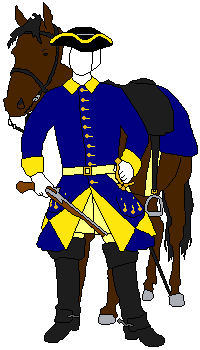
Estonian Adelsfana
1708/09
|
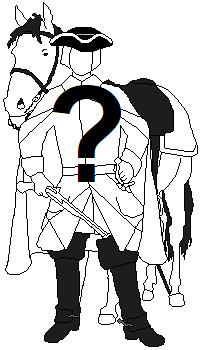
Pommeranian &
Bremen-Verden Adelsfana
|
|
Höglund describes uniforms that are identical
with the Swedish Adelsfana (1689-1704) but provides no dates
for the Baltic units. |
Höglund only writes that they had hat, blue coat, leather vest
and leather breeches. But the regiments in the Baltic provinces appear to have
been uniformly dressed at this time, so both the Estonian and Livonian Adelsfana
probably looked like the picture above. |
|
|
Uppland 3-männing Regiment
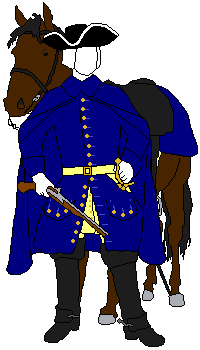
1700-1704 |
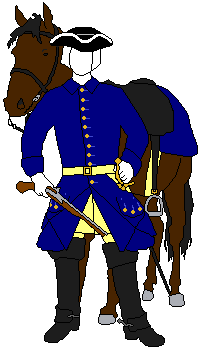
1704-1709? |
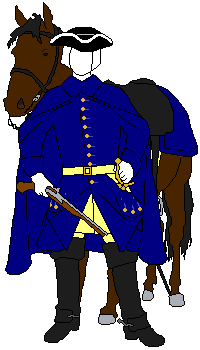
1712-1719 |
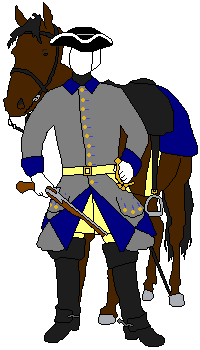
1719 |
Had both white and black neckcloths in 1700. The uniform issued in 1704 is
unknown. The one that was issued in 1712, when the regiment was
restored, had the same colours as the one from 1700.
The regiment received new uniforms in 1719, which consisted of: hat
with lace, vadmal pie coat, vadmal coat, vest made of leather
or vadmal and a black neckcloth. However, it was disbanded the same year and
the cavalrymen were transferred to Uppland Stånd Dragoons. The colour of the
shabraque is not mentioned at any point in time. |
|
Other 3-männings and
5-männings

Skånska 3-männings
1701-1711 |
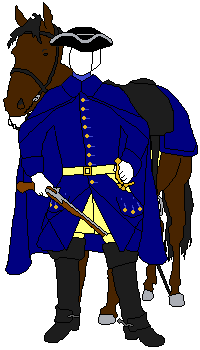
Skånska 3-männings
1711-1721
|
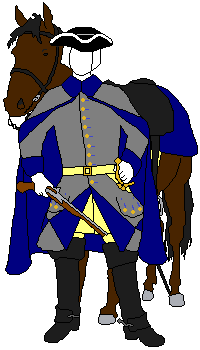
Västgöta 3-männings
1704-1716 |
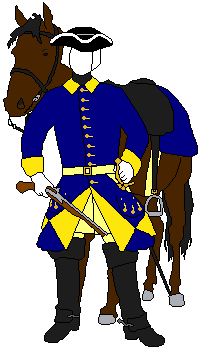
Uppland 5-männings
1710-1715 |
|
Were given Södra Skånska’s ten-year-old uniforms when it
was raised in 1700 and still wore these when the Danes invaded Scania
1709. Colour of hat lace, buttons and shabraque unknown. The shabraques
were however blue in 1712. |
Colours of the lining, cuffs, vest and
breeches are not mentioned. |
Coat and cloak of vadmal without description of colours.
Hat lace not mentioned either. |
Hat lace and button colour unknown, but in 1716 they had
pewter buttons and the trumpeters had white lace.
The colour of the shabraque is not mentioned at any point in time. |
|
|
Skånska
ståndsdragonerna
"Scanian Estate Dragoons"
|
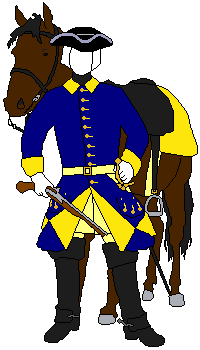
1702 |
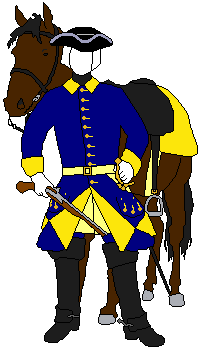
1703 |
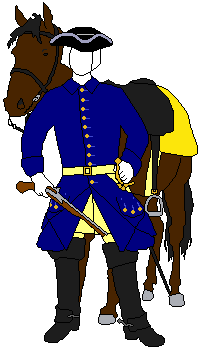
1707-1709 |
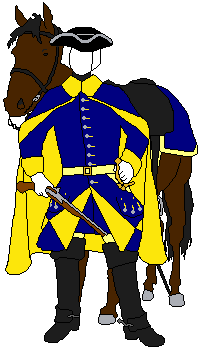
1716-1719 |
|
The hat had lace but the
colour is not mentioned. In addition to the regular coat, they also had a
blue piecoat |
Hat lace, button colour and vest are not mentioned. Höglund's
information applies to 1704, but the breeches were blue as early as 1703
according to Coyet's journal. |
The regiment ceased to exist
after the Battle of Poltava. The uniform that was issued to the
restored regiment in 1712 is completely unknown. |
According to Höglund, the
lining of the coat and cloak was blue. However, information provided to
me by Magnus Lindskog states yellow lining in 1716. New uniform issued in 1719
which according to Höglund was identical to the one from 1716. |
A company and command journal written by Gustaf Wilhelm Coyet 1702-1704
contains information about the regiment's uniforms. In June 1702, it is
mentioned that the dragoons must have their hats cocked and turnbacks om their coats coats.
In July 1703, blue breeches and yellow stockings were delivered. In November
1703 it is mentioned that the regiment still had piecoats but in May 1704
new recruits arrived and cloaks are mentioned. In December 1704 black neckcloths
are mentioned.
The colour of the shabraques and pistol covers are completely unknown for the
entire time period, but I have made an assumption that all "ståndsdragoner"
had the same colours on these items. |
|
Other "Stånd" Dragoons
"Estate Dragoons"
|
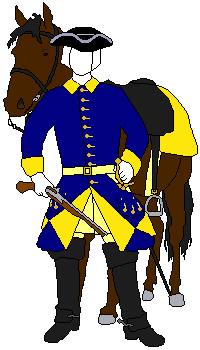
Uppland
1704-1709 |
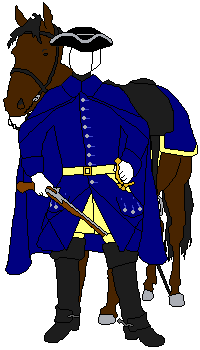
Uppland
1716/1717 |
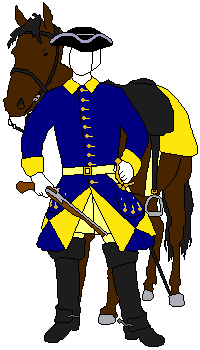
Västgöta
1704-1712 |
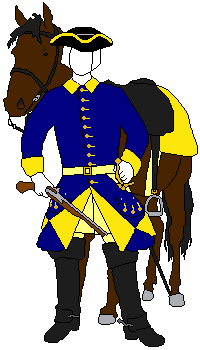
Västgöta
1712-1716 |
|
Restored in 1712 and
according to Höglund, in 1714 they had the same uniform as 1704 but with
a blue cloak instead of a blue piecoat. |
The uniform information comes from Anders Larsson. According to Höglund,
they had blue vests in 1718 when they ha been issued new uniforms. |
Also had a grey piecoat. |
New hats and coats were
issued in 1716 but without details of colours. However, the vest and breeches were
made of leather. |
The colour of the shabraques and pistol covers are only mentioned for
Uppland Stånd Dragoons. But because theirs were yellow in 1704 and the
Öselska Land Dragoons, which were recruited in the same way, also had
yellow shabraques, I have made the assumption that all Stånd Dragoons
were issued yellow shabraques (with a blue edge?) at that time.
The
uniforms for the Finnish Stånd Dragoons
are completely unknown and the Gotland Stånd
Dragoons are only known to have had blue coats in 1705. |
|
Land Dragoons
The uniform for
Laurentzen's Free Dragoons is completely unknown. This unit, which existed
1701-1706, was raised by the burghers in Wenden, Wolmar, Walk and Lemsal.
|
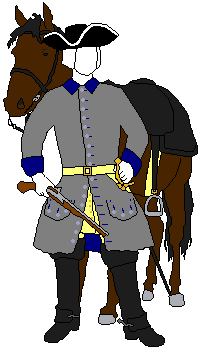
Estonian Land Dragoons
1701 (according to Kroon) |
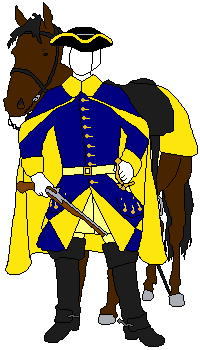
Ösel Land Dragoons
1703-1708 |
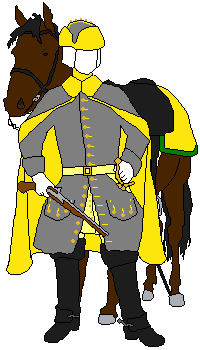
Livonian Land Dragoons
1701 (according to Kroon) |
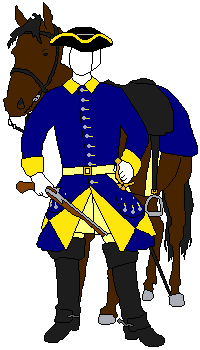
Livonian Land Dragoons
1708 (according to Höglund) |
|
Hat lace and shabraques are not mentioned but the pistol
covers were black.
Höglund states that they had karpus, grey vadmal coat
with pewter buttons and yellow cuffs, leather vest, leather breeches. At
the muster the same year complaints were made of coats without lining
and other deficiencies. |
Hat lace unknown, but yellow was a common colour in
Lewenhaupt's corps. |
Shabraques are not mentioned.
Höglund states that they in 1701 had blue karpus with
yellow lining, pie coat with pewter buttons, blue coat with pewter
buttons, leather vest, leather breeches and likely blue shabraques and
pistol covers. In 1706 the breeches were blue. |
The only details that are mentioned are: hat, blue coat
with yellow lining and cuffs. But compare with his description of the
1701 uniform. |
|
|
The Drabants Corps
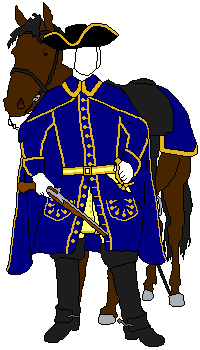
1700-? |
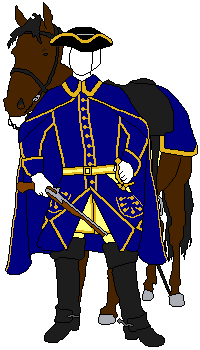
?-1716 |
The uniforms are only described for the year 1700 and then really only
in the form of lists of how much material was used for them. |
|
Enlisted
Cavalry Regiments
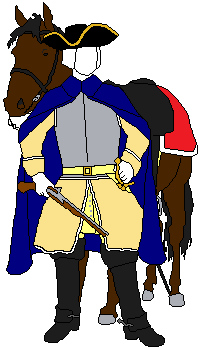
Estonian Cavalry Regiment
1697-? |
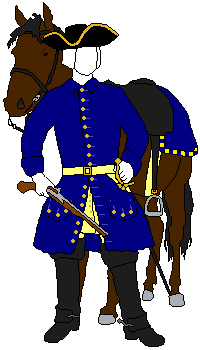
Bremen Cavalry Regiment
1701-? |
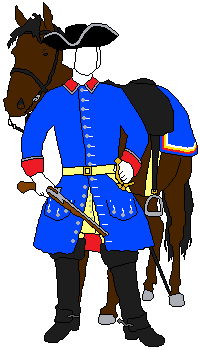
Pomeranian Cavalry Regiment
1702-? |

Vallack Regiment
Niester Dragoon Reg.
Polish Regiment on Horse
Red coats in 1718 |
|
According to Lars-Eric Höglund, the shabraques were
white, while Anders Larsson states that they were red. No one mentions
any colour on the edge, but it is my own "compromise" that matches the
coat. |
The shabraques were decorated with the royal cypher and
crown in yellow. |
The shabraques were decorated with count Mellin’s coat of
arms in the outer corners. Colour of the vest is unknown. According to
Anders Larsson, they had silver lace hat, collar and cuffs. |
|
|
Livdragonerna
(Life Dragoons)
|
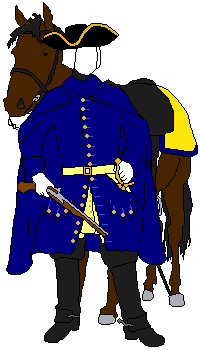
Narva 1700 |
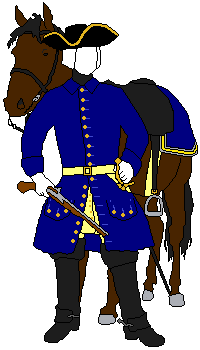
Kliszow 1702 |
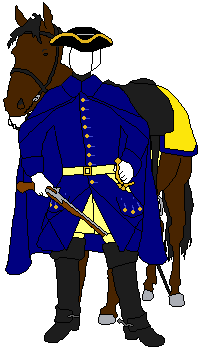
Fraustadt 1706 |
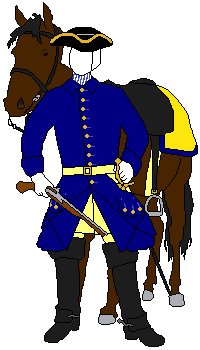
Poltava 1709 |
With the exception of the neckcloth, the Life Dragoons appear to have had
the same uniform colours throughout the war. When the regiment was raised
in 1700 they received black neckcloths, in 1707 they received blue and
white striped neckcloths and in 1716-18 black and white neckcloths were
issued to the life dragoons.
However, the colour of the
hat lace is only mentioned in 1707 when it was made of gold, while in
1700 it is only stated to have been made of camel hair.
The
colour the shabraques is only mentioned at the beginning of the war. In
1700, they were yellow with a blue edge, while the non-commissioned
officers had shabraques was made of "blue cloth decorated with yellow and silver lace around
it". The privates' shabraques were still yellow with a blue edge
according to
a source from 1703. The
pistol covers were yellow (yellow baize and leather according to
Larsson).
|
|
Enlisted Dragoons
|
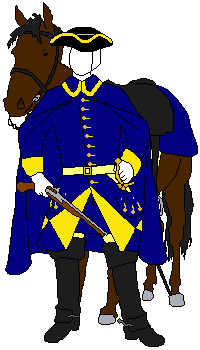
W. A. Schlippenbach's
Dragoon Regiment
1703-1709 |
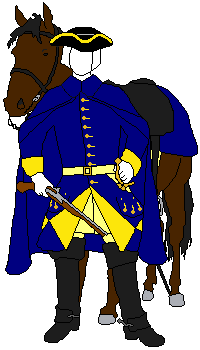
Schreiterfeldt's
Dragoon Regiment
1703-1709 |
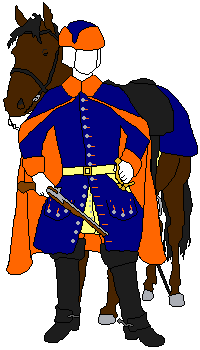
A. J. Schlippenbach's (Skogh's) Squadron
1701 |

Skogh's
Dragoon Squadron
ca 1708 |
|
Yellow pistol covers. Colour on cuffs and lining unknown |
Colour on cuffs, lining, buttons and hat lace unknown. Was called G. E. d'Albedyhl until 1704. |
Vest, buttons and shabraque unknown.
Became Skogh's squadron in 1706. |
The only mentioned colours are blue for the coat and
leather for vest and breeches. |
|
The yellow colour on cuffs, lining and
hat lace for the three regiments above is guesswork based on the fact
that the regiments in Lewenhaupt’s corps appear to have been uniformly
dressed. |
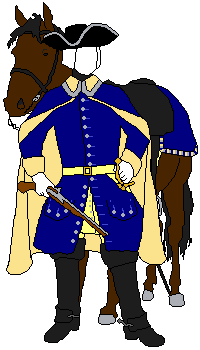 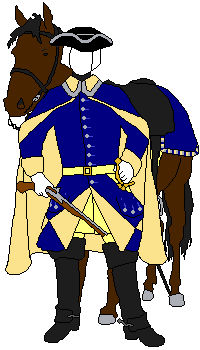
Bremen Dragoons
1700-1704
The uniform that was issued in 1704 is unknown. |
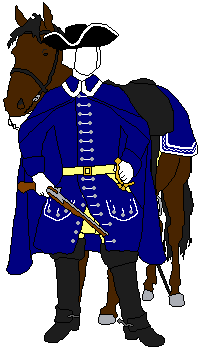 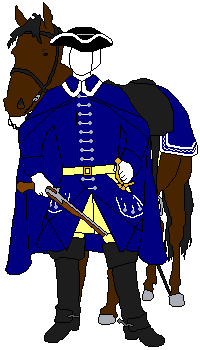
Verden Dragoons
1703-? |
|
According to
Höglund, the pistol covers had the same colour as the cuffs
(chamois-yellow). While the shabraque is specified as blue, with blue and
yellow edge for privates, and yellow edge and silver lace for
non-commissioned officers.
Anders
Larsson describes the shabraque as blue with "silver and blue/yellow
round cord studded". For non-commissioned officers
they were "of blue cloth with "a hand's breadth" chamois coloured cloth
band around and on either side of the yellow band a blue/yellow/silver
cord. Corporals' cord of white/blue/silver". |
According to
Höglund, the pistol covers and shabraques were blue with a white edge. For
non-commissioned officers, these were also blue with silver lace.
Anders
Larsson describes no pistol covers and only the non-commissioned
officers' shabraques, which were blue with a silver lace two times
around and between these a serpentine-shaped narrower silver lace.
My shabraques
follow Larsson's description of the non-commissioned officers, but with
white instead of silver. |
|
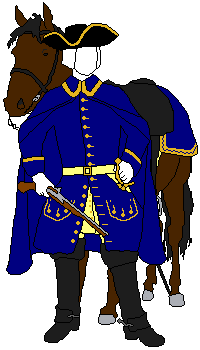 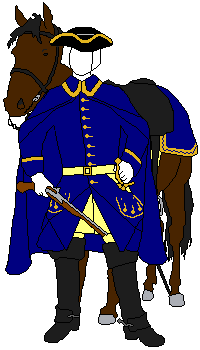
Pomeranian Dragoons
1703-? |
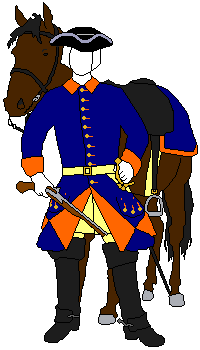
Meijerfelt's
Dragoon Regiment
1706-1709
Button and shabraque colour unknown. |
|
Anders
Larsson describes the shabraques as blue "with a thick gold-yellow camel
hair lace embedded and then with a 2-finger wide golden yellow thick
camel hair lace studded. In the middle with a blue winding seam
studded".
The
non-commissioned officers' shabraques and pistol covers were "of blue
cloth with with a wide gold lace and another 1 ½ finger wide
lace". |
|
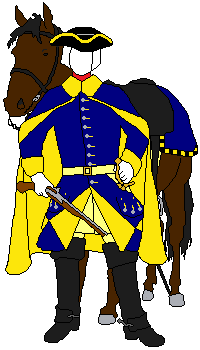 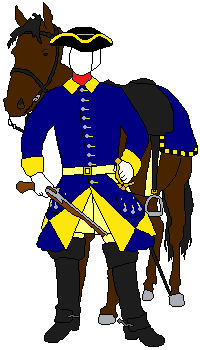
Hielm's
Dragoon Regiment
1705-1709 |
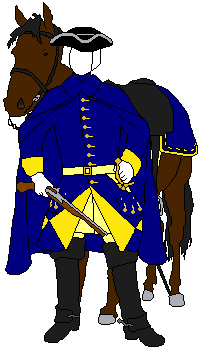 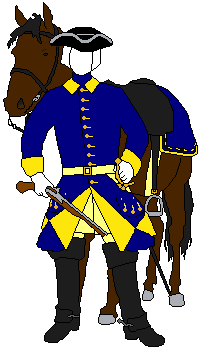
Dücker's
Dragoon Regiment
1705-1709 |
|
Yellow pistol covers with blue edge. Blue shabraques decorated
with the royal cipher in yellow edged with yellow and black thread. |
According to
Anders Larsson: "Blue cloth shabraque underlined with black linen.
Studded with a yellow wide camelhair ledge and with a narrower one
of the same kind which is also made with yellow cloth and decorated with blue and
yellow lace." |
|
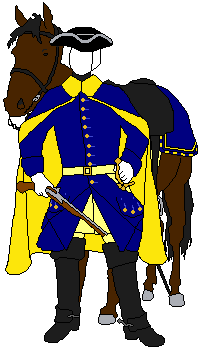 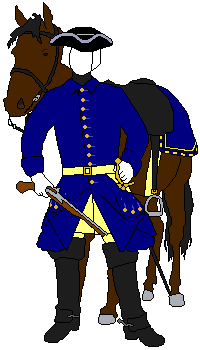
Taube's
Dragoon Regiment
1704-1709 |
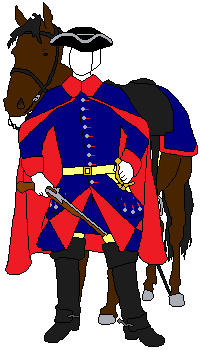 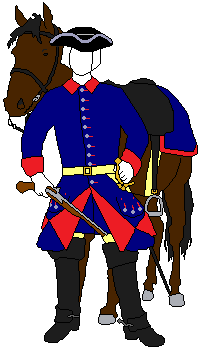
Gyllenstierna's and d'Albedyhl's
Dragoon Regiments
1706-1709 |
|
According to Höglund: yellow pistol covers with blue edge.
Blue shabraque with yellow edge, laced with blue and yellow cord. The
pictures above follow the illustration in Höglund's book.
Larsson describes the shabraque as blue "with blue and
yellow edge, yellow name cipher and crown in the outer corners. A
blue/yellow round cord attached with blue/yellow lace. Yellow pistol
covers with a blue band around." |
Raised in 1706 as one regiment but was soon split into
two. |
|

French
Dragoon Regiment
1707-1715 |

Bender
Dragoon Regiment
1712-1715 |
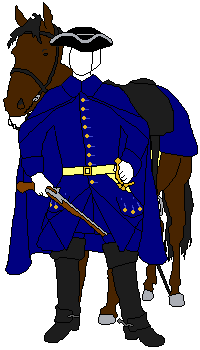
Tyska (German) Dragoon Regiment
1716? |
|
Was originally
a French grenadier regiment captured at the Battle of Blenheim.
Transferred to Saxon service and was again captured at the Battle of
Fraustadt after which it entered Swedish service as an
infantry
battalion. Was captured by the Saxons in the Battle of Kalisz but
returned to the Swedish army and then converted into a dragoon regiment. |
Formed by the ethnic Swedes in Bender. |
Only a proposal for uniforms and it is unclear if it was issued.
The shabraque is not mentioned. The regiment was formed in 1716 by the
remnants of the other regiments in Pomerania. When it was mustered in the
late winter, early spring of 1716, it had very diverse
uniforms. They consisted of hats with or without lace, or karpuses.
Grey, blue, red, brown or black coats. Camisoles of leather or blue or
brown cloth. Leather breeches or grey vadmal breeches. |
|
|
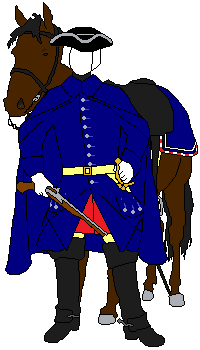
Schwerin's
Dragoon Regiment
1710-1715 |

Smiegelski's Polish Dragoon Squadron
1711-1713 |
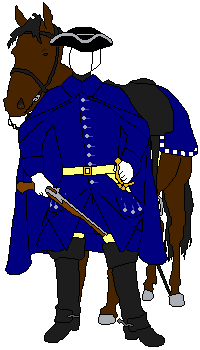
Bassewitz'
Dragoon Regiment
1711-1715 |
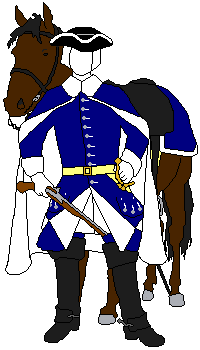
Vietinghoff's
Dragoon Regiment
1714-1715 |
|
|
 Horse
Grenadiers Horse
Grenadiers
This regiment, which was meant to be raised in 1706, was never fully recruited.
The enlistment patent was issued to Albrecht Otto von Hagen on 13 June
1706, but already on 17 November, Hagen died in a duel in Vilnius after
which his regiment was disbanded. According to the patent, the regiment was
to consist of 600 men and Hagen stated at one point that he had recruited 200
men. What happened to the crew after his death is unknown.
The uniform was decided by Charles XII in October 1706 to consist of coats
and cloaks lined with fine yellow baize, elk hide camisoles and buckskin
breeches. The grenadier caps are called karpuses and, like the grenadier
bags, would have embroidered fronts of cloth (the cap in the
picture is speculative). Schabraques and pistol covers were to consist of
black leather. However, it is highly doubtful that these uniforms were delivered
as Hagen died only a month later. Interestingly, Hagen had wanted the entire
uniform to be made of cloth (including lining and schabraques) but the king
felt that the uniform would then be too heavy. |
|
Battle Paintings

A detail of Daniel Stawert's battle painting from 1706 of the Battle of
Narva that hangs inside Drottningholm Palace.
The pictorial
evidence of the appearance of the uniforms at the beginning of the war comes
mainly from battle paintings of the battles of Narva and Düna. The pictures
at the top and bottom are details from these, but a more detailed
description of what they show can be found in Erik Bellander's book "Dräkt
och uniform" (page 217-218). The descriptions are quoted here and begin with
the account of Daniel Stawert's paintings in Drottningholm:
Narva. Among the
foot soldiers in the foreground is a soldier in a long, blue coat, where
the skirts are not folded up, and a hat with a brim particularly folded at
the front. The cavalrymen wear blue coats, one of which is fur lined
and one of which has red lining, red collar and drooping red cuffs. The
cloaks are blue, one of them fitted with a medium blue, distinctly angular
collar. Two cavalrymen wear red cloaks. No turnbacks can be discerned. In
two cases there is a hat with a fur brim and a red hill. it is almost a
matter of karpus here. Otherwise, the headgear consists of a hat, which is
more folded up than before and sometimes approaches the tricorne type.
Düna. The foot soldiers
wear long coats without turnbacks. The hats are more or less turned up, some
three-sided. A couple of non-commissioned officers wear hats that are
high-slung in the front. One clearly has white socks. The same applies to
the cavalrymen, who lack buff coats. The hats are not triangular. a
Saxon cavalryman, on the other hand, has turnbacks.
Another battle painter from
these first years of the Great Northern War was Joh. Lithén (ennobled
Litheim), who followed Dahlberg in the field. His presentation of the Battle
of Narva shows, among other things, the following details. The
cavalry, which dominates the foreground, has indistinct turnbacks. The
hats are folded up all around but not fastened. Only two officers and a
couple of privates have a three-sided raised, but not attached, brim. A
cavalryman wears a karpus-like headdress. Almost all cavalrymen have long
hair, an officer and some privates have also a hair pouch. The foot
soldiers wear hats with irregularly folded up brims, in one case a hair
pouch.
Battle paintings give a good indication of what the
contemporary uniforms looked like, but they definitely cannot be compared to
photographs of battles. To the extent that the artists did not have enough
information about something, they used their imagination to fill in the
knowledge gaps. A lot of battle paintings are therefore very unreliable. In
the picture below, for example, we see a blue-clad cavalryman with red
lining on his coat in the Battle of Düna. No regiment with that colour
combination took part in the battle.

A detail of Daniel Stawert's battle painting from 1707 of the
Battle of Düna that hangs inside Drottningholm Palace.
See also the Swedish infantry uniforms
and the Finnish regiments' uniforms There si also
a more detailed article about the Evolution of the
Swedish Carolean uniform. |
|
References
Bellander, Erik. Dräkt och uniform. Stockholm (1973).
Höglund, Lars-Eric – Sallnäs, Åke. Stora nordiska kriget 1700-1721 - Fanor och uniformer. Karlstad (2000).
Höglund, Lars-Eric – Sallnäs, Åke. Stora nordiska kriget 1700-1721, II. Karlstad (2003).
Larsson, Anders. Karolinska uniformer och munderingar åren 1700-1721. Östersund (2022).
The information from Kalle Kroon comes from an e-mail he has sent me, but I have
published it on my blog. |
|

